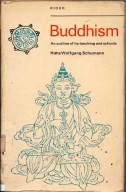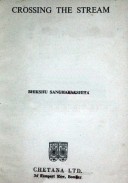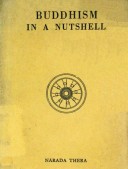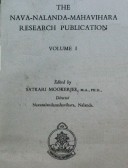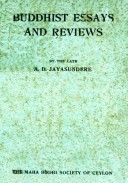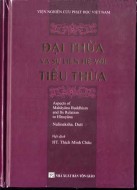Tìm Sách
Sách tiếng Anh-English >> Buddhism and Outline of Its Teachings And Schools
Thông tin tra cứu
- Tên sách : Buddhism and Outline of Its Teachings And Schools
- Tác giả : Hans Wolfgang Schumann
- Dịch giả : Georg Fenerstein
- Ngôn ngữ : Anh
- Số trang : 200
- Nhà xuất bản : Rider & Company - London
- Năm xuất bản : 1973
- Phân loại : Sách tiếng Anh-English
- MCB : 12010000002996
- OPAC :
- Tóm tắt :
Buddhism and Outline of Its Teachings and Schools
H. WOLFGANG SCHUMANN
Translated by Georg Fenerstein
RIDER AND COMPANY LONDON
Hans Wolfgang Schumann was born in Dusseldorf in 1928. After training as a journalist and serving an apprenticeship to a publishing house, he studied Indology, Comparative religion and social anthropology gaining a PhD at Bonn University in 1957 for a contribution to Buddhist research. From 1957 to 1960 he was editor of an export journal. In 196o he went to India as a lecturer at Banaras Hindu University up to 1963. In that year he was appointed Press Attaché at the German Consulate General in Calcutta. From 1968-1971 he was Press and Cultural Attaché in Rangoon. He is now posted to Chicago. Dr Schumann is an honorary Fellow of the Indian Government Sanskrit College, Calcutta.
This book outlines the three main systems of Buddhism: Theravada, Mahàyàna and Tantrayana, basing all its statement on the original sources in Pali and Sanskrit. In treating the three main branches and their various schools independently, the author demonstrates that such key terms as nibbana (Pali) and Nirvana (Sanskrit), dhamma and dharma, and others, do not bear identical meanings in the early and later Buddhist systems. In this respect the book represents a corrective against the present trend of identifying all Buddhist ideas and ideals with each other, and distinguishes it from all other surveys. The chapter on the Theravada as well as those on the Mahàyàna contains many new research findings, in particular on the kamma doctrine, conditioned origination, meditation, the dharma theory, the relationship between Human and Transcendent Bodhisattvas, the concept of the Mahàyànic Nirvana, the Yogacara School, and the basic ideas of Tantrayana. The strictly systematical arrangement of the material and the analytical-descriptive method used in disentangling the otherwise rather confusing Mahàyàna teachings into distinct “Ways to Liberation” make the book a reliable guide through the vast field of Buddhism not only for the general reader but also for the expert.
The concluding chapter gives a philosophical summary of the teachings of all the three branches of Buddhism and is complemented by a chart for quick reference. The text in complemented by numerous photographs and drawings.
CONTENTS
List of Drawings and Plates
Preface
Introduction
I THE BUDDHA’S LIFE
II HÌNAYÀNA – THE BUDDHISM OF LIBERATION THROUGH SELF-EFFORT
Councils and Sources
The teachings of the Theravàda
1. All Existence is Suffering
2. The Subject of Suffering and the Three Marks
3. (Excursus) Objective and Subjective Existence
4. The Cycle of Rebirth
5. The Doctrine of Kamma
6. The Cause of Rebirth
7. Conditioned Origination
8. The Nexus of Conditioned Origination in Detail
9. Conditioned Origination as the Foundation of Individual Existence
10. The Termination of Suffering
11. The Eightfold Way to the Termination of Suffering
12. The Goal: Nibbàna
The Main School of the Hìnayàna
III. MAHÀYÀNA – THE MONISTIC BUDDHISM OF LIBERATION BY “OTHER- POWER”
Hìnayàna and Mahàyàna – Contrasts and Similarities
The Sanskrit Literature of the Mahàyàna
The Basic Teachings of the Mahàyàna
1. The Buddhology
2. The Doctrine of the Three Bodies
I. Dharmakàya
II. Sambhogakàya
III. Nirmànakàya
3. The Boddhisattvas
The Mahàyànic Ways to Liberation and Nirvàna
1. All Existence is Suffering
2. The Way of Self-discipline
3. The Way of Wisdom
4. The Bodhisattva Way
5. The Way of Faith
6. The Cultic Way
7. The Goal: Nirvàna
IV. PHILOSOPHICAL SCHOOLS OF THE MAHÀYÀNA
The Madhyamaka – (Sùnyatàvàda) System
1. Thinkers and Sàstras
2. Teachings
The Yogacàra – (Vijnànavàda) System
1. Thinkers and Sàstras
2. Teachings
V. THE TANTRAYÀNA AND THE BUDDHISM OF EAST-ASIA
VI. A CULTURAL- HISTORICAL SURVEY
VII. TABULATED SYNOPSIS
VIII. LITERATURE
1. Abbreviations and Text Editions
2. Translations of Indian Works; Secondary Literature
Index
 Facebook
Facebook
 Google
Google
 Google+
Google+
